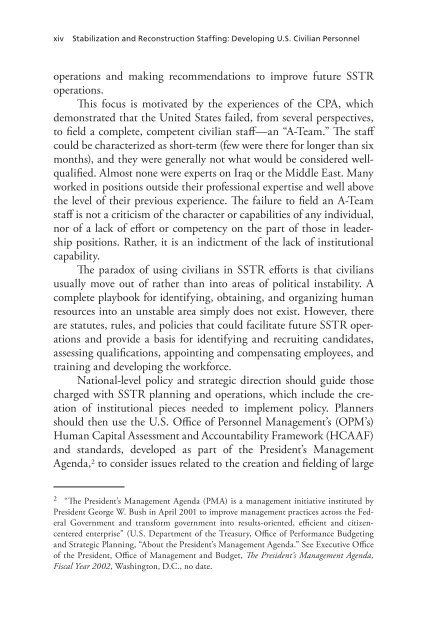Stabilization and Reconstruction Staffing - RAND Corporation
Stabilization and Reconstruction Staffing - RAND Corporation
Stabilization and Reconstruction Staffing - RAND Corporation
You also want an ePaper? Increase the reach of your titles
YUMPU automatically turns print PDFs into web optimized ePapers that Google loves.
xiv<strong>Stabilization</strong> <strong>and</strong> <strong>Reconstruction</strong> <strong>Staffing</strong>: Developing U.S. Civilian Personneloperations <strong>and</strong> making recommendations to improve future SSTRoperations.This focus is motivated by the experiences of the CPA, whichdemonstrated that the United States failed, from several perspectives,to field a complete, competent civilian staff—an “A-Team.” The staffcould be characterized as short-term (few were there for longer than sixmonths), <strong>and</strong> they were generally not what would be considered wellqualified.Almost none were experts on Iraq or the Middle East. Manyworked in positions outside their professional expertise <strong>and</strong> well abovethe level of their previous experience. The failure to field an A-Teamstaff is not a criticism of the character or capabilities of any individual,nor of a lack of effort or competency on the part of those in leadershippositions. Rather, it is an indictment of the lack of institutionalcapability.The paradox of using civilians in SSTR efforts is that civiliansusually move out of rather than into areas of political instability. Acomplete playbook for identifying, obtaining, <strong>and</strong> organizing humanresources into an unstable area simply does not exist. However, thereare statutes, rules, <strong>and</strong> policies that could facilitate future SSTR operations<strong>and</strong> provide a basis for identifying <strong>and</strong> recruiting c<strong>and</strong>idates,assessing qualifications, appointing <strong>and</strong> compensating employees, <strong>and</strong>training <strong>and</strong> developing the workforce.National-level policy <strong>and</strong> strategic direction should guide thosecharged with SSTR planning <strong>and</strong> operations, which include the creationof institutional pieces needed to implement policy. Plannersshould then use the U.S. Office of Personnel Management’s (OPM’s)Human Capital Assessment <strong>and</strong> Accountability Framework (HCAAF)<strong>and</strong> st<strong>and</strong>ards, developed as part of the President’s ManagementAgenda, 2 to consider issues related to the creation <strong>and</strong> fielding of large2 “The President’s Management Agenda (PMA) is a management initiative instituted byPresident George W. Bush in April 2001 to improve management practices across the FederalGovernment <strong>and</strong> transform government into results-oriented, efficient <strong>and</strong> citizencenteredenterprise” (U.S. Department of the Treasury, Office of Performance Budgeting<strong>and</strong> Strategic Planning, “About the President’s Management Agenda.” See Executive Officeof the President, Office of Management <strong>and</strong> Budget, The President’s Management Agenda,Fiscal Year 2002, Washington, D.C., no date.
















